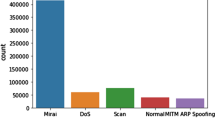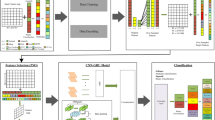Abstract
The rapid growth of Internet of Things (IoT) devices has changed human interactions with the environment. IoT networks require specialized defense strategies distinct from traditional corporate contexts. Security measures such as anti-malware software, firewalls, authentication protocols, and encryption techniques are established but face limitations against evolving attack strategies. Therefore, this study proposes an intrusion detection approach for a realistic IoT environment, employing various variants of deep learning models such as deep neural networks (DNNs), convolutional neural networks (CNNs), and recurrent neural networks (RNNs). The research tested three variants for each model: DNN1, DNN2, DNN3, CNN1, CNN2, CNN3, RNN1, RNN2, RNN3. All these variants are customized and tuned differently to analyze the efficacy of the suggested methodology. Likewise, notable observation highlights the significance of aligning training and validation accuracy curves that indicate controlled overfitting, validating the model’s reliability in accurately predicting intrusion and benign network traffic in IoT settings. Results reveal that RNN1 achieves the best results: accuracy of 98.61%, precision of 98.55%, recall of 98.61%, and F1-score of 98.57% compared with other DNN and CNN architectures and benchmark papers. This study advances intrusion detection within IoT networks through a comprehensive evaluation of deep learning models and inspires ongoing research to enhance intrusion detection systems’ resilience in dynamic IoT environments.




Similar content being viewed by others
Explore related subjects
Discover the latest articles, news and stories from top researchers in related subjects.Data availability
Data sources are highlighted in the paper.
Code availability
The authors can provide the code on demand.
References
Zhang H, Li B, Karimi M et al (2023) Recent advancements in IoT implementation for environmental, safety, and production monitoring in underground mines. IEEE Internet Things J 10(16):14507–14526. https://doi.org/10.1109/JIOT.2023.3267828
Prathyusha MR, Bhowmik B (2023) IoT evolution and recent advancements. In: 2023 9th International Conference on Advanced Computing and Communication Systems (ICACCS), pp 1725–1730. https://doi.org/10.1109/ICACCS57279.2023.10112761
Rahman MA, Asyhari AT, Wen OW et al (2021) Effective combining of feature selection techniques for machine learning-enabled IoT intrusion detection. Multimed Tools Appl 1–19
Thakkar A, Lohiya R (2021) A review on machine learning and deep learning perspectives of ids for IoT: recent updates, security issues, and challenges. Arch Comput Methods Eng 28:3211–3243
Srinivas J, Das AK, Kumar N (2019) Government regulations in cyber security: framework, standards and recommendations. Future Gener Comput Syst 92:178–188
Al-Garadi MA, Mohamed A, Al-Ali AK et al (2020) A survey of machine and deep learning methods for internet of things (IoT) security. IEEE Commun Surv Tutor 22(3):1646–1685
Neto ECP, Dadkhah S, Ferreira R et al (2023) Ciciot2023: a real-time dataset and benchmark for large-scale attacks in IoT environment. Sensors
Lopez-Martin M, Carro B, Sanchez-Esguevillas A et al (2017) Conditional variational autoencoder for prediction and feature recovery applied to intrusion detection in IoT. Sensors 17(9):1967
Moustafa N, Turnbull B, Choo KKR (2018) An ensemble intrusion detection technique based on proposed statistical flow features for protecting network traffic of internet of things. IEEE Internet Things J 6(3):4815–4830
Aversano L, Bernardi ML, Cimitile M et al (2021) Effective anomaly detection using deep learning in IoT systems. Wirel Commun Mob Comput 2021:1–14
Ullah I, Mahmoud QH (2022) Design and development of RNN anomaly detection model for IoT networks. IEEE Access 10:62722–62750
Bostani H, Sheikhan M (2017) Hybrid of anomaly-based and specification-based IDS for internet of things using unsupervised OPF based on MapReduce approach. Comput Commun 98:52–71
Diro AA, Chilamkurti N (2018) Distributed attack detection scheme using deep learning approach for internet of things. Future Gener Comput Syst 82:761–768
Pajouh HH, Javidan R, Khayami R et al (2016) A two-layer dimension reduction and two-tier classification model for anomaly-based intrusion detection in IoT backbone networks. IEEE Trans Emerg Top Comput 7(2):314–323
Gangadhar MS, Sai KVS, Kumar SHS et al (2023) Machine learning and deep learning techniques on accurate risk prediction of coronary heart disease. In: 2023 7th International Conference on Computing Methodologies and Communication (ICCMC), pp 227–232. https://doi.org/10.1109/ICCMC56507.2023.10083756
Zollanvari A (2023) Deep learning with Keras-TensorFlow. Springer, Cham, pp 351–391. https://doi.org/10.1007/978-3-031-33342-2_13
Michelucci U, Michelucci U (2019) Tensorflow: advanced topics. In: Advanced applied deep learning: convolutional neural networks and object detection, pp 27–77
Kramer O (2016) Scikit-learn. Springer, Cham, pp 45–53. https://doi.org/10.1007/978-3-319-33383-0_5
Chen X, Zhang J, Lin B et al (2022) Energy-efficient offloading for DNN-based smart IoT systems in cloud-edge environments. IEEE Trans Parallel Distrib Syst 33(3):683–697. https://doi.org/10.1109/TPDS.2021.3100298
Totakura V, Janmanchi MK, Rajesh D et al (2020) Prediction of animal vocal emotions using convolutional neural network. Int J Sci Technol Res 9(2):6007–6011
Zhang Z (2018) Improved adam optimizer for deep neural networks. In: 2018 IEEE/ACM 26th International Symposium on Quality of Service (IWQoS), pp 1–2. https://doi.org/10.1109/IWQoS.2018.8624183
Smys DS, Basar DA, Wang DH (2020) CNN based flood management system with IoT sensors and cloud data. J Artif Intell Capsule Netw 2(4):194–200
Gou F, Wu J (2022) Message transmission strategy based on recurrent neural network and attention mechanism in IoT system. J Circuits Syst Comput 31(07):2250126
Schratz P, Muenchow J, Iturritxa E et al (2019) Hyperparameter tuning and performance assessment of statistical and machine-learning algorithms using spatial data. Ecol Model 406:109–120. https://doi.org/10.1016/j.ecolmodel.2019.06.002
Acknowledgements
The authors extend their appreciation to the Deanship of Scientific Research at King Khalid University for supporting this research.
Funding
The authors extend their appreciation to the Deanship of Scientific Research at King Khalid University for funding this work through large group Research Project under Grant Number RGP2/470/44.
Author information
Authors and Affiliations
Contributions
“Conceptualization, Sidra Abbas, Gabriel Avelino Sampedro; Data curation, Sidra Abbas, Ahmad Almadhor; Formal analysis, Sidra Abbas, Gabriel Avelino Sampedro, Stephen Ojo, Shtwai Alsubai, Ahmad Almadhor, Imen Bouazzi , Abdullah Al Hejaili; Funding acquisition, Abdullah Al Hejaili; Investigation, Gabriel Avelino Sampedro, Stephen Ojo, Ahmad Almadhor, Imen Bouazzi, Abdullah Al Hejaili; Methodology, Sidra Abbas, Abdullah Al Hejaili, Gabriel Avelino Sampedro; Supervision, Sidra Abbas, Imen Bouazzi, Abdullah Al Hejaili; Validation, Gabriel Avelino Sampedro, Stephen Ojo, Shtwai Alsubai, Ahmad Almadhor, Imen Bouazzi, Abdullah Al Hejaili, Sidra Abbas; Visualization, Sidra Abbas; Writing Origional Draft, Gabriel Avelino Sampedro, Stephen Ojo, Shtwai Alsubai, Ahmad Almadhor, Imen Bouazzi , Abdullah Al Hejaili, Sidra Abbas; Writing – review & editing, Gabriel Avelino Sampedro, Stephen Ojo, Shtwai Alsubai, Ahmad Almadhor, Imen Bouazzi , Abdullah Al Hejaili, Sidra Abbas;
Corresponding author
Ethics declarations
Conflict of interest
The authors share no conflict of interest.
Additional information
Publisher's Note
Springer Nature remains neutral with regard to jurisdictional claims in published maps and institutional affiliations.
Rights and permissions
Springer Nature or its licensor (e.g. a society or other partner) holds exclusive rights to this article under a publishing agreement with the author(s) or other rightsholder(s); author self-archiving of the accepted manuscript version of this article is solely governed by the terms of such publishing agreement and applicable law.
About this article
Cite this article
Abbas, S., Alsubai, S., Ojo, S. et al. An efficient deep recurrent neural network for detection of cyberattacks in realistic IoT environment. J Supercomput 80, 13557–13575 (2024). https://doi.org/10.1007/s11227-024-05993-2
Accepted:
Published:
Issue Date:
DOI: https://doi.org/10.1007/s11227-024-05993-2




